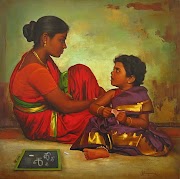Tu Zhiwei was born in 1951 to peasant parents in a remote rural village in Liu-Li Township, Weng-Yuan County in northern Guang-Dong Province, China. Like other boys of the village, as a child Tu helped to work the land, barefoot most of the time, and performed the menial tasks expected of every peasant child. He spent his days herding sheep and gathering food. Thus, his early life was much the same as that of his ancestors.
When he began attending the local village school Tu was issued a slate, chalk, rough paper, and pencil for school work. With these crude instruments he early demonstrated an extraordinary talent for drawing which captivated the attention and wonder of his teachers. In the village of his youth, however, drawing was an amusing pastime with no practical application or use, and so the young boy received little encouragement.
Prodigy
When he began attending the local village school Tu was issued a slate, chalk, rough paper, and pencil for school work. With these crude instruments he early demonstrated an extraordinary talent for drawing which captivated the attention and wonder of his teachers. In the village of his youth, however, drawing was an amusing pastime with no practical application or use, and so the young boy received little encouragement.
Prodigy
it was not until the equivalent of high school age that Zhiwei first saw oil paints being used to create brightly colored images. The way this discovery came about is truly a remarkable story.
The government in Beijing had dispatched an experienced artist to the village to create a huge picture of Chairman Mao Tse-tung. Young Zhiwei happened by one afternoon and saw the painter at work. Fascinated, he watched for hours on end and finally asked the man if he could have samples of his paints. Zhiwei took them to the equivalent of the village pharmacy. There, he acquired cans of paint which he mixed at home into more than a dozen different shades.
The next day, instead of going to school Zhiwei returned to the site where the artist was still at work on the portrait. The boy boldly set up a work space next to the artist and began painting his own portrait of Mao. When both the artist and the boy were done, the village elders were shocked to discover that Zhiwei's portrait of Mao was far superior. They even selected it for public display instead of the artist's own painting.
The government in Beijing had dispatched an experienced artist to the village to create a huge picture of Chairman Mao Tse-tung. Young Zhiwei happened by one afternoon and saw the painter at work. Fascinated, he watched for hours on end and finally asked the man if he could have samples of his paints. Zhiwei took them to the equivalent of the village pharmacy. There, he acquired cans of paint which he mixed at home into more than a dozen different shades.
The next day, instead of going to school Zhiwei returned to the site where the artist was still at work on the portrait. The boy boldly set up a work space next to the artist and began painting his own portrait of Mao. When both the artist and the boy were done, the village elders were shocked to discover that Zhiwei's portrait of Mao was far superior. They even selected it for public display instead of the artist's own painting.






















0 Comments